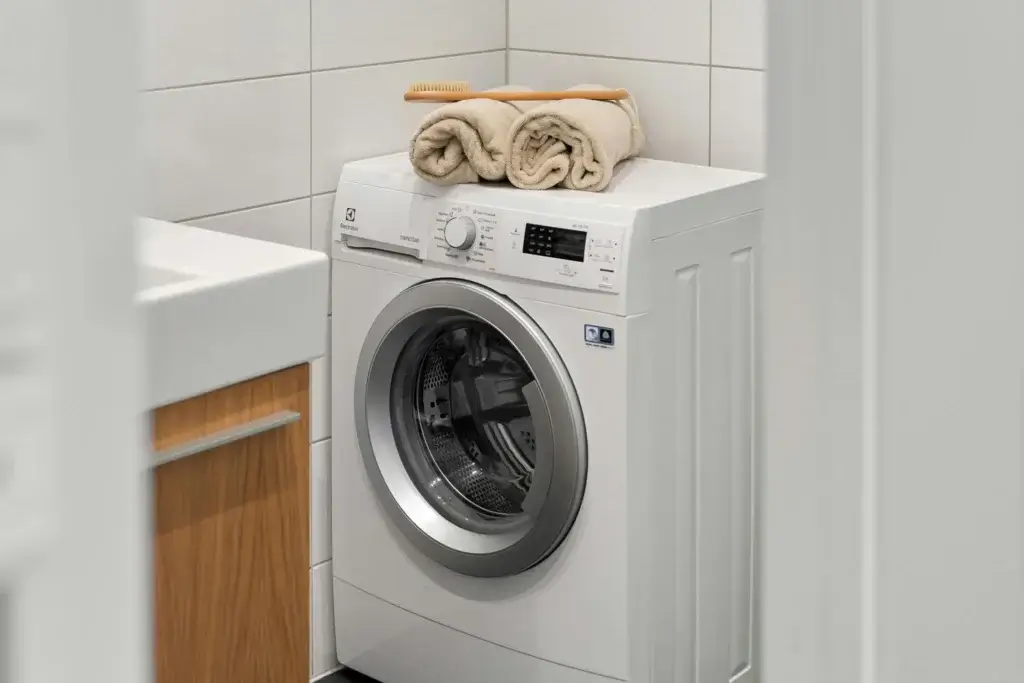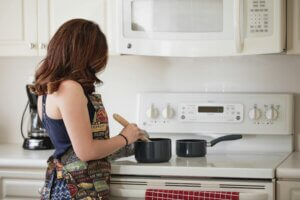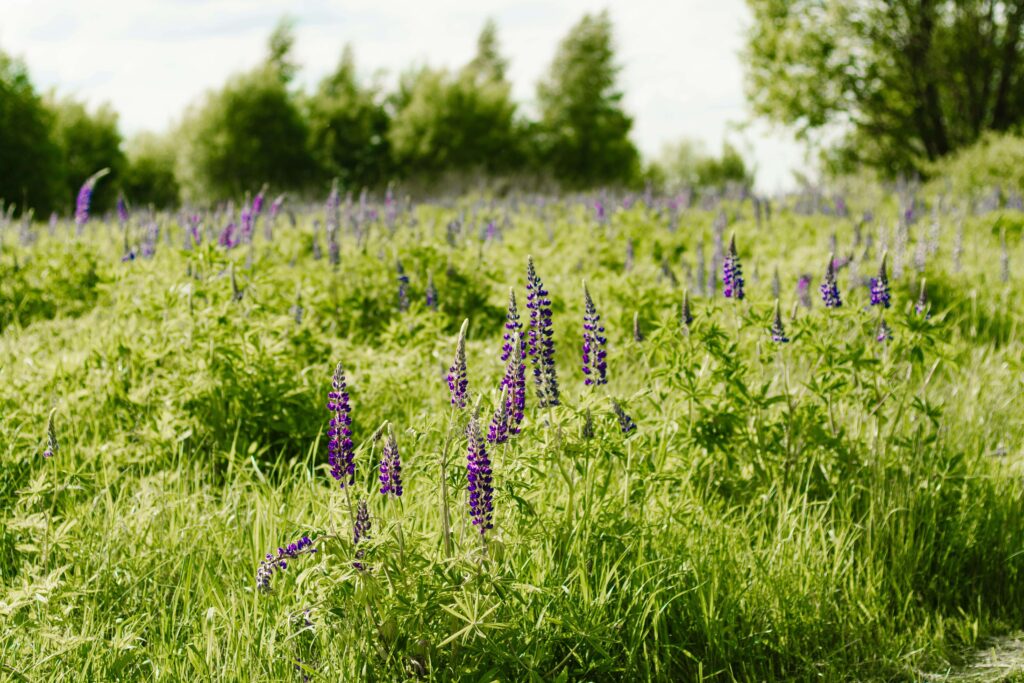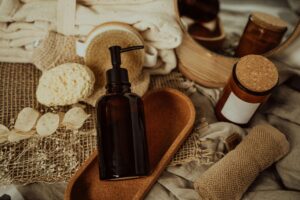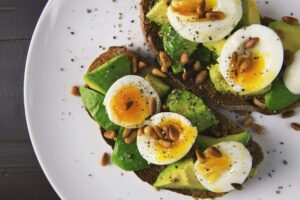Disclaimer: This post contains affiliate links, including links to Amazon. As an Amazon Associate, we earn from qualifying purchases at no additional cost to you. Thank you for supporting Low Tox & Thrive!
Our laundry rooms are one of the most frequently used spaces in the home, yet they often contain some of the harshest chemicals and synthetic fragrances that affect our health.
From detergents and fabric softeners to dryer sheets and stain removers, these products can release a variety of toxins into the air and onto our clothes, lingering on the fabric that touches our skin daily. Studies show that certain laundry products emit volatile organic compounds (VOCs), which can impact indoor air quality and cause skin and respiratory irritations.
The good news is that a few small changes can make a big difference. By switching to non-toxic laundry options, creating simple DIY products, and making smart choices about ventilation and storage, you can create a laundry room that’s healthier for you and your family, and plays a major role in creating an overall low tox home.
Benefits of a low tox laundry room
Creating a low tox laundry room has benefits that go beyond cleaner clothes. Here are some more reasons why upgrading this space is worth your while:
Reduced skin irritation
Switching to non-toxic detergents and eliminating synthetic fragrances can make a big difference for sensitive skin, especially for those prone to eczema, allergies, or rashes.
Improved indoor air quality
By removing chemical-laden products from your laundry room, you reduce the release of VOCs and other airborne irritants that impact air quality.
Less environmental impact
Choosing natural detergents and making your homemade cleansers reduces the number of harmful chemicals released into the water supply.
Better fabric longevity
Harsh chemicals can break down fibers over time, causing clothes to fade and wear out more quickly. Using gentle, non-toxic detergents and natural softeners helps maintain the quality and color of your clothes, keeping them looking newer for longer.
How to create a low tox laundry room in 5 steps
Step 1: Choose a non-toxic laundry detergent
Many commercial detergents contain a range of harsh chemicals, including sulfates, phosphates, optical brighteners, synthetic fragrances, and dyes. These ingredients can stick to your clothes, irritate your skin, and release fumes into the air.
Instead, here’s what to look for in a non-toxic detergent:
- Fragrance-free or naturally scented: Synthetic fragrances are a major source of indoor air pollution, and they often contain phthalates, which can disrupt hormones. Opt for fragrance-free detergents or those scented with natural essential oils.
- Free of sulfates and phosphates: Sulfates, like sodium lauryl sulfate (SLS), create a foaming effect but can be harsh on skin and may irritate sensitive areas. Phosphates can build up in water systems, causing harm to aquatic life. Look for formulas without these additives, especially if anyone in your household has sensitive skin.
- No optical brighteners or dyes: Optical brighteners are chemicals that make clothes appear brighter by reflecting light, but they can linger on fabrics and cause skin irritation. As for dyes, they serve no functional purpose in detergents and can cause sensitivity in some people, so it’s best to avoid them altogether.
- Eco-certifications: Look for detergents that carry certifications like EWG Verified, USDA Organic, or EPA Safer Choice, which help verify their safety. These labels provide assurance that the product meets strict health and environmental standards.
These detergents from Molly’s Suds or ECOS are good natural options.
DIY option: Basic laundry detergent recipe
Making your own laundry detergent can be simple, cost-effective, and ensures complete control over the ingredients. Here’s a DIY detergent recipe that provides powerful cleaning while keeping toxins at bay.
This recipe is simple and effective, using ingredients that are tough on dirt but gentle on skin.
Ingredients
- 1 cup washing soda (sodium carbonate)
- 1 cup baking soda (sodium bicarbonate)
- ½ cup liquid Castile soap
- Optional: 10-15 drops of essential oil, such as lavender or lemon, for a natural scent
Instructions
- In a large mixing bowl, combine the washing soda and baking soda.
- Slowly add the Castile soap, mixing well to avoid clumping.
- Add essential oils if desired, and stir thoroughly.
- Store in an airtight container, using 2 tablespoons per load of laundry.
Step 2: Swap out dryer sheets for low tox alternatives
Dryer sheets are often coated in artificial fragrances, synthetic softeners, and other chemicals that can release into the air as they heat up. Here are a few healthier alternatives that keep clothes soft and reduce static cling without chemicals.
- Wool dryer balls: Wool dryer balls are reusable, affordable, and help reduce drying time by creating air pockets in the laundry. Add a few drops of essential oil to the dryer balls before tossing them in with your clothes for a light, natural scent.
- Vinegar rinse: Adding ½ cup of white vinegar to your rinse cycle can soften clothes naturally and help prevent static. Don’t worry about any lingering vinegar smell—it evaporates as clothes dry.
DIY option: Make your own reusable dryer sheets
Make your own reusable dryer sheets by soaking cloth squares in a mixture of water and vinegar, with a few drops of essential oil for scent. Wring out the cloth and toss it in the dryer with your clothes.
Step 3: Make your own natural stain removers
Stain removers are often loaded with harsh chemicals, but it’s easy to make effective, non-toxic alternatives using common household ingredients.
- Baking soda paste: Mix baking soda with a small amount of water to form a paste. Apply to the stain, let it sit for 15–30 minutes, then rinse. This works well on greasy or oil-based stains.
- Lemon juice and salt: For brightening whites and removing rust stains, sprinkle salt on the stain, squeeze fresh lemon juice over it, and let it sit in the sun for a natural bleaching effect. Rinse after 30 minutes.
- Hydrogen peroxide and dish soap: Mix 1 part dish soap with 2 parts hydrogen peroxide, then apply directly to stains. This solution works well on tough stains like wine, grass, and blood. Test a small area first, as hydrogen peroxide can bleach some fabrics.
Step 4: Ensure proper ventilation in the laundry room
If your laundry room lacks ventilation, it’s easy for chemical vapors and moisture to accumulate, which can lead to poor air quality and even mold growth. Here’s how to improve ventilation and air quality in your laundry area:
- Open windows or use a fan: If possible, open a window or run a fan during and after washing and drying clothes to disperse any fumes or moisture. This helps to reduce the buildup of chemical residues in the air.
- Use a dehumidifier: Laundry rooms are often humid spaces, and excess moisture can lead to mold and mildew. Using a dehumidifier helps keep humidity levels down, preventing mold growth and improving air quality.
- Regularly clean the lint trap and dryer vent: A buildup of lint in the trap and dryer vent not only increases the risk of fire but can also reduce air quality. Empty the lint trap after every use, and check the dryer vent regularly to keep air flowing freely.
Step 5: Store products in glass or stainless steel containers
Many commercial laundry products come in plastic packaging that can leach chemicals over time, especially when stored in humid environments. Transferring your detergents, softeners, and other laundry supplies to glass or stainless steel containers reduces the risk of plastic exposure—not to mention keeps your laundry room looking organized and stylish!
- Glass jars: Store your DIY detergent powders and other bulk ingredients in airtight glass jars. This not only prevents plastic leaching but also keeps the products dry and fresh.
- Stainless steel bottles: For liquid detergents and vinegar solutions, stainless steel bottles with pump tops or spray nozzles are both functional and safe, reducing exposure to plastic over time.
A low tox laundry room for a healthier home
Creating a low tox laundry room is easier than it may seem and offers many benefits for your health and your home. By choosing non-toxic detergents, making your own DIY products, and incorporating natural alternatives, you can create a laundry space that’s both safer and more sustainable.
Enjoyed this post? Check out our guides to creating a low tox bedroom and low tox bathroom next.

